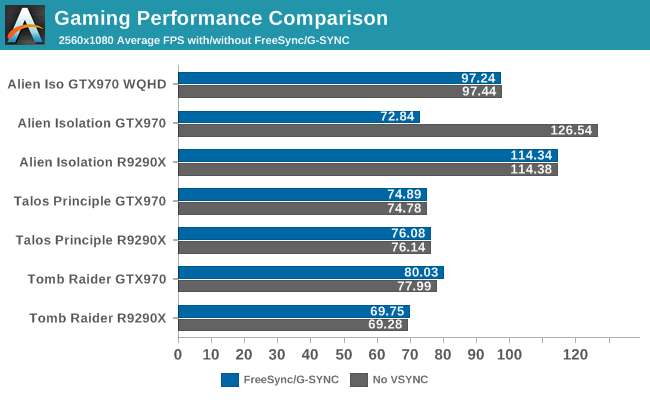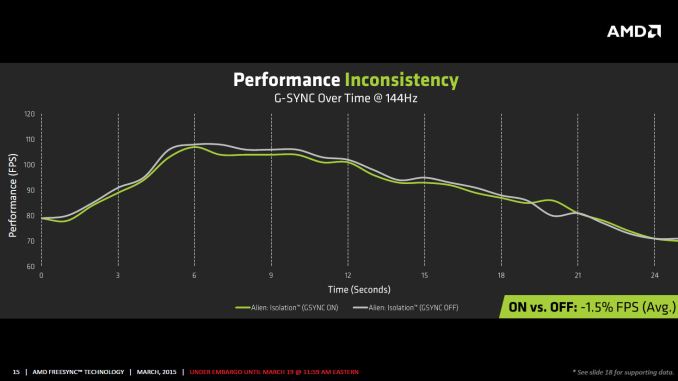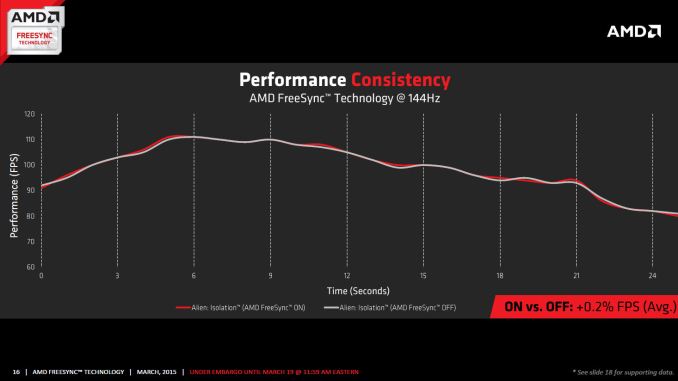The AMD FreeSync Review
by Jarred Walton on March 19, 2015 12:00 PM ESTFreeSync vs. G-SYNC Performance
One item that piqued our interest during AMD’s presentation was a claim that there’s a performance hit with G-SYNC but none with FreeSync. NVIDIA has said as much in the past, though they also noted at the time that they were "working on eliminating the polling entirely" so things may have changed, but even so the difference was generally quite small – less than 3%, or basically not something you would notice without capturing frame rates. AMD did some testing however and presented the following two slides:
It’s probably safe to say that AMD is splitting hairs when they show a 1.5% performance drop in one specific scenario compared to a 0.2% performance gain, but we wanted to see if we could corroborate their findings. Having tested plenty of games, we already know that most games – even those with built-in benchmarks that tend to be very consistent – will have minor differences between benchmark runs. So we picked three games with deterministic benchmarks and ran with and without G-SYNC/FreeSync three times. The games we selected are Alien Isolation, The Talos Principle, and Tomb Raider. Here are the average and minimum frame rates from three runs:


Except for a glitch with testing Alien Isolation using a custom resolution, our results basically don’t show much of a difference between enabling/disabling G-SYNC/FreeSync – and that’s what we want to see. While NVIDIA showed a performance drop with Alien Isolation using G-SYNC, we weren’t able to reproduce that in our testing; in fact, we even showed a measurable 2.5% performance increase with G-SYNC and Tomb Raider. But again let’s be clear: 2.5% is not something you’ll notice in practice. FreeSync meanwhile shows results that are well within the margin of error.
What about that custom resolution problem on G-SYNC? We used the ASUS ROG Swift with the GTX 970, and we thought it might be useful to run the same resolution as the LG 34UM67 (2560x1080). Unfortunately, that didn’t work so well with Alien Isolation – the frame rates plummeted with G-SYNC enabled for some reason. Tomb Raider had a similar issue at first, but when we created additional custom resolutions with multiple refresh rates (60/85/100/120/144 Hz) the problem went away; we couldn't ever get Alien Isolation to run well with G-SYNC using our custome resolution, however. We’ve notified NVIDIA of the glitch, but note that when we tested Alien Isolation at the native WQHD setting the performance was virtually identical so this only seems to affect performance with custom resolutions and it is also game specific.
For those interested in a more detailed graph of the frame rates of the three runs (six total per game and setting, three with and three without G-SYNC/FreeSync), we’ve created a gallery of the frame rates over time. There’s so much overlap that mostly the top line is visible, but that just proves the point: there’s little difference other than the usual minor variations between benchmark runs. And in one of the games, Tomb Raider, even using the same settings shows a fair amount of variation between runs, though the average FPS is pretty consistent.


















350 Comments
View All Comments
chizow - Friday, March 20, 2015 - link
Yeah np, 2nd paragraph after the CCC Picture, it clearly states FreeSync panels begin exhibiting ghosting bleow 60Hz.https://translate.google.com/translate?sl=auto&...
You can thank me later for saving you $500+ on a 1st Gen FreeSync panel with ghosting problems that would frankly make it unusable to most.
I am sure we will see more reviews once reviewers actually get samples they can keep and aren't forced to use in AMD's controlled test environment...
silverblue - Saturday, March 21, 2015 - link
I said plural only because you implied it. More links still required.chizow - Saturday, March 21, 2015 - link
You can use google just as well as I can, I am sure. 2 links are plenty, especially when they actually give photo evidence of the problem.chizow - Monday, March 23, 2015 - link
Another confirmation of the problem from Forbes, with quotes from Petersen:http://www.forbes.com/sites/jasonevangelho/2015/03...
The fact Jarred and AT not only missed this, but have actively made excuses/denied it is pretty appalling as more and more reviewers are making note of the ghosting and flickering problems with FreeSync.
anubis44 - Tuesday, March 24, 2015 - link
@chizow: "Read some actual reviews that clearly show right now FreeSync is the inferior solution."You mean, as opposed to all the 'virtual' reviews we've been reading that all say the same thing: that FreeSync does exactly what G-Sync does, except for free? Clearly, a green goblin lover like yourself must respect techreport.com, a blatantly pro-nVidia website plain and simple, and even their response to FreeSync? I quote Scott Wasson:
"Now, I have only had a few hours with the BenQ XL2730Z (our review sample arrived yesterday afternoon), but my first impressions are just this: AMD has done it. They've replicated that sense of buttery smooth animation that a fast G-Sync display will get you, and they've done it in a way that squeezes the extra costs out of the monitors. This is a very good thing."
I'll repeat that operative part of the quote so you can't possibly overlook or ignore it. AMD has "DONE IT. They've REPLICATED THAT SENSE OF BUTTERY SMOOTH ANIMATION that a fast G-Sync display will get you, and they've done it in a way that SQUEEZES THE EXTRA COSTS OUT OF THE MONITORS."
This is all that the vast legions of gamers are going to care about: same buttery smooth performance, less cost. QED.
chizow - Tuesday, March 24, 2015 - link
Yeah, they are virtual reviews, done in controlled test environments in a limited period of time just as noted in that review. Now that actual live samples are coming in however, a LOT of problems are creeping up outside of the controlled test environments.And before you attack the author's credibility, as I'm sure you will, keep in mind this guy has been a huge AMD advocate in the past:
http://www.forbes.com/sites/jasonevangelho/2015/03...
"Note to readers: I have seen this firsthand on the Acer FreeSync monitor I’m reviewing, and PC Perspective noticed it with 2 additional FreeSync monitors, the BenQ XL2730Z and LG 34UM67. To illustrate the problem they recorded the aforementioned monitors running AMD’s Windmill demo, as well as the same demo running on a G-Sync enabled Asus ROG Swift. Ignore the stuttering you see (this is a result of recording at high speed) and pay attention to the trailing lines, or ghosting. I agree that it’s jarring by comparison."
anubis44 - Tuesday, March 24, 2015 - link
@maximumGPU: Oh, but chizow DOES believe it. He believes that the green goblin on the box is the hallmark of quality, and that nVidia NEVER makes any mistakes, NEVER rips off its customers, and NEVER cheats or lies, or acts deceptively, because 'it's all business'. In other words, he's a sociopath. He BELIEVES G-Sync MUST be better than FreeSync because there's a green goblin-labelled chip in the G-Sync monitor that MUST be doing SOMETHING the FreeSync monitor just cannot do. It just HAS to be better, because he PAID for it. LOLchizow - Tuesday, March 24, 2015 - link
Who cares about all that noise? They still offer the best product at any given price point if you can afford a slightly better product. Only sycophants like you go into the stupid and inane morality of it, same way you begrudge Intel for putting their boot to AMD's neck in the CPU market.Buy what gives you the best product for your money and needs, who cares about the rest.
medi03 - Thursday, March 19, 2015 - link
GSync is a shameless attempt to ban competition.AMD couldn't use it even if it would PAY for it.
On the contrary, FreeSync, being VESA standard, can be freely used by any GPU manufacturer, including Intel and nVidia.
Frenetic Pony - Thursday, March 19, 2015 - link
It's adaptive sync but worse in every way. What is possibly good about it?